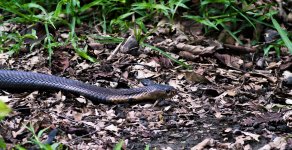Ben88
Well-known member
Jeppe Bundgaard photographed this snake while we were birding/mammal-watching at Kaziranga NP in Assam, India. The local guide called it a King Cobra, but he also said every flying Thick-billed Warbler was a Slender-billed Babbler and every singing one was a Marsh Babbler. Is this a King Cobra, or another species of snake, and why?





